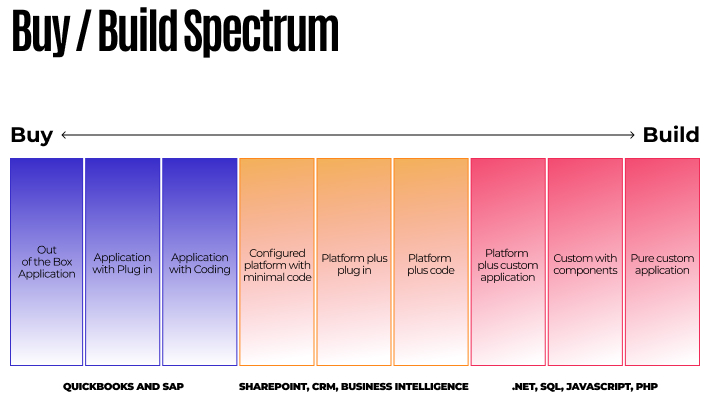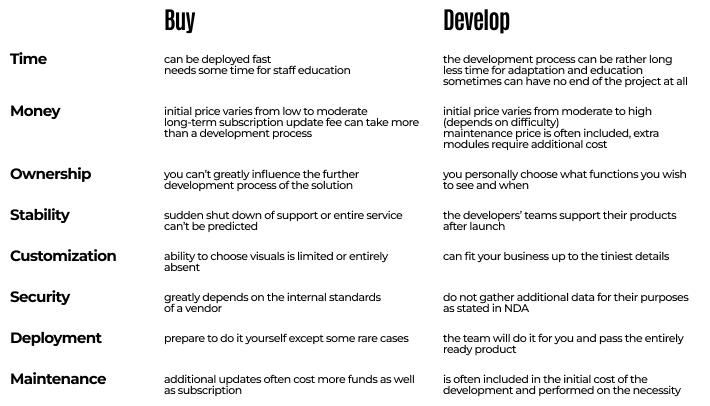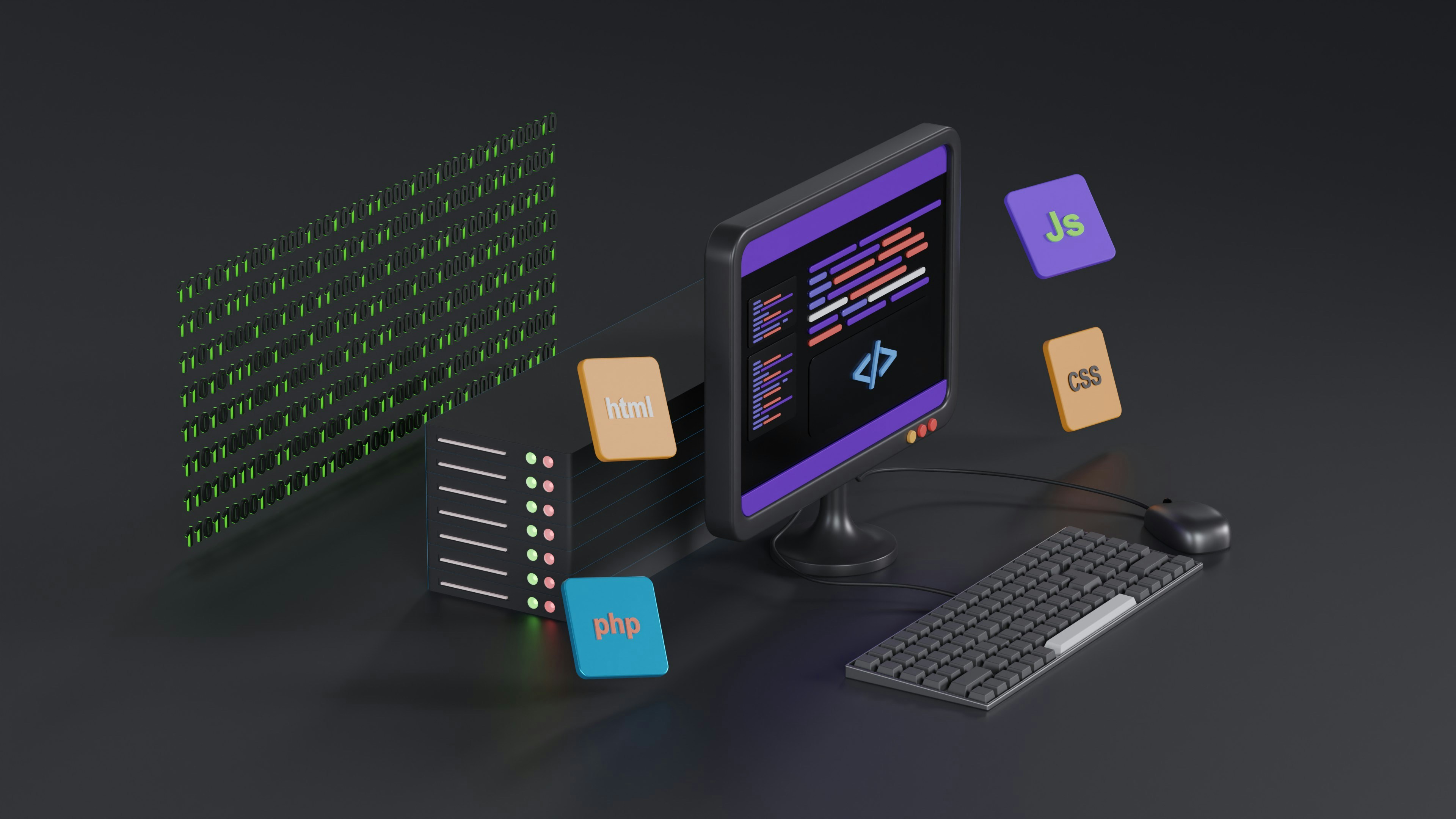To buy or to develop?… a crucial question indeed. Making the wrong decision here can cause harm to your operation, both financial and reputation.
In this article, we will look at the pros and cons of each of these options. You will find a short comparison table at the end to enable you to perform a quick check.
Every action your business takes must have a purpose. The necessity for new software could be a result of an outdated system that requires an upgrade. This may be to introduce fresh standards or internal processes. Whatever the reason, the business should define whether it purchases the required software or develop its own.
Define the aim of the solution
The first and the main step you need to do before starting custom software development is to specify whether your business and, as a result, a product should have some unique features or aspects. After defining this attribution, it is possible to make your choice once without long calculations. Every custom solution is called to satisfy the final goals and needs. In case you need a simple text editor without the ability to transform your text into a 3D interactive image, the development of a custom solution will only take time and money.

Where it is possible to save more time
Every Off-The-Shelf solution takes time when a business opts for a particular program they need. On the other hand, it can be purchased quickly, deployed within the business easily and with maybe a bit of staff training, it is ready to go.
Now for personal development, choose your developers, complete the necessary documentation, and begin the project. The specific terms of the actual development process depend on the complexity of the final product. This, can take anything from weeks to, in some cases, years to achieve.
As for the solution, it will be developed according to your requirements. The staff being able to know its functions, and learn how best to use them. As a result, after deployment, you have a Ready to Use product.
Time is precious and time is also money, so don’t waste it on solutions that can wait. Do what needs to be done first. Calculate and define the most crucial modules/functions, develop and deploy, the rest can be introduced at a later stage.
Where it is possible to save more capital
When purchasing Off-The-Shelf solutions you have to pay the initial costs of developing the product along with additional upgrade or feature costs too. This can result in the purchase price, in the long term, being higher than a comparative custom development.
When developing a custom solution package you pay for the entire product creation there and then and use it whenever you wish. The things you can pay after launch can include: development of new modules, scaling of functions, database broadening.
Some development teams offer free maintenance after launch for their products but do not forget to have this stated in the documentation though. In any case, you are the one who decides how much you are willing to spend on the development while vendors can sometimes dictate subscription charges for a product in low competitive niches.

Ownership and stability
Proprietary rights to a digital product may also differ in the following ways.
Using a vendor for a digital product is risky in its own way, vendors come and go, often with little or no notice. This can result in crucial loss of activity for all users of the product. With larger, more established renowned companies however this is far less likely to happen, the larger companies know they are more reliable in this manner and this reliability is often reflected in their service costs.
Additionally, as you don’t own the solution you have very little influence on its functions. Some you would like to see more of and maybe others less. All you can do is convey your suggestions to the support team and hope for a sufficient number of similar requests.
Using cloud services has the drawback of sometimes being inaccessible due to technical issues. Vendors will endeavour to fix these outages as soon as possible but there are no guarantees of quick fixes.
When developing your own solution, you make it suit your business needs. You have the ability to dictate which features/functions are included and which features/functions you wish to omit or postpone. Your team will help and advise you on this. This again will enable you to be the decision-maker.
After the end of the project, depending on the specification stated in the agreement, you can own that product outright. Your development team will be happy to assist an owner with further development.
Customization
In order to customise you need to make choices. Which functions are to be included and which are to be omitted? It’s almost impossible to find a product that perfectly suits every situation when it comes to the companies needs. Also in the pursuit of saving money quality may also suffer.
Some business owners focus on the general impression of the solution, this runs the risk of making it an over complex interface which some users find difficult to operate successfully.
On the other hand, you being the owner of the product gives you licence to customise it as you wish.
Security
It is risky to underestimate the importance of security when it comes to the company’s internal information and processes. Vendors cannot guarantee that their users’ data is beyond the reach of the hacker. Some services can be utilised directly on the company hardware but this can create a backdoor for malicious intent. Basically, we have to rely on the vendors’ standards and quality of their codes for security.
The personally developed software is autonomous, and all data in the solution belongs solely to the company. Each and every solution undergoes rigorous testing for external security breaches. This is all part of development standards.
Data cannot be collected due to standard non-disclosure agreements signed before any development commences.
Long term collaboration and maintenance
When purchasing an Off-The-Shelf solution, you should be able to install/deploy it yourself or have a fellow developer assist you. In some cases, vendors offer their support in the deployment process.
Maintenance can be performed via various updates from the vendor, but these may be subject to further costs. Little in this world comes free of charge, unfortunately.
By using development teams to make the product from start to successful deployment you will find everything is done for you.
Maintenance costs can be easily included in the product development costings, and remember, you have the entire team who will do their utmost to get your product working as it should.
Future features can also be introduced by your dedicated team even years after initial deployment.
The relative comparative table
The conclusion can be visualized through such a table defining the main points that can influence the decision to each of the sides.

When any businesses realise that they need to introduce some digital renovation to their processes they simply do it. You have the choice of whether to buy or develop depending on the functions required and you have the pro’s and con’s of each option.
Anyway, the primary task is to find the right tools that can satisfy the core goal which is prosperity and success. And any high-grade digital product is the right way to achieve this.


















